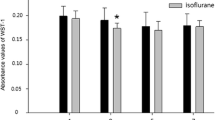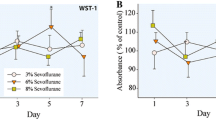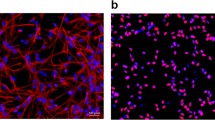Abstract
Sevoflurane anesthesia in infant rats can result in long-term cognitive impairment, possibly by inhibiting neurogenesis. The hippocampus is critical for memory consolidation and is one of only two mammalian brain regions where neural stem cells (NSCs) are renewed continuously throughout life. To elucidate the pathogenesis of sevoflurane-induced cognitive dysfunction, we measured the effects of clinical sevoflurane doses on the survival, proliferation, and differentiation of hippocampal NSCs. Neural stem cells were isolated from Sprague–Dawley rat embryos, expanded in vitro, and exposed to sevoflurane at 0.5, 1, or 1.5 minimal alveolar concentration (MAC) for 1 or 6 h. Two days after treatment, cell viability, cytotoxicity, and apoptosis rate were estimated by WST-1 assay, lactate dehydrogenase (LDH) activity, and TdT-mediated dUTP-biotin nick end labeling (TUNEL), respectively, while proliferation rate was assessed by 5-ethynyl-2′-deoxyuridine (BrdU) incorporation and Ki67 staining. Differentiation was assayed 7 days after treatment by immunocytochemistry and Western blots of neuron and glial markers. The phosphorylation level of p44/42 extracellular regulated kinases (ERK1/2) was measured in the proliferation and differentiation phases respectively. Sevoflurane at 1 MAC or 1.5 MAC for 1 h increased viable cell number whereas a 6 h exposure at these same concentrations suppressed proliferation and promoted apoptotic death (P < 0.01). Sevoflurane had no effect on NSC differentiation, and a sub-clinical concentration (0.5 MAC) altered neither proliferation nor viability. The phosphorylation level of ERK1/2 increased after 1 h of 1 MAC or 1.5 MAC of sevoflurane exposure in the proliferation phase, but not in the differentiation phase. Brief (1 h) exposure to sevoflurane at clinical concentrations enhanced proliferation of cultured NSCs possibly mediated by ERK1/2, but a 6 h exposure suppressed proliferation and induced apoptosis. Prolonged sevoflurane exposure may decrease the self-renewal capacity of hippocampal NSCs, resulting in cognitive deficits.




Similar content being viewed by others
References
Wilder RT, Flick RP, Sprung J, Katusic SK, Barbaresi WJ, Mickelson C, Gleich SJ, Schroeder DR, Weaver AL, Warner DO (2009) Early exposure to anesthesia and learning disabilities in a population-based birth cohort. Anesthesiology 110:796–804
Stratmann G, Sall JW, May LD, Bell JS, Magnusson KR, Rau V, Visrodia KH, Alvi RS, Ku B, Lee MT, Dai R (2009) Isoflurane differentially affects neurogenesis and long-term neurocognitive function in 60-day-old and 7-day-old rats. Anesthesiology 110:834–848
Jevtovic-Todorovic V, Hartman RE, Izumi Y, Benshoff ND, Dikranian K, Zorumski CF, Olney JW, Wozniak DF (2003) Early exposure to common anesthetic agents causes widespread neurodegeneration in the developing rat brain and persistent learning deficits. J Neurosci 23:876–882
Trouche S, Bontempi B, Roullet P, Rampon C (2009) Recruitment of adult-generated neurons into functional hippocampal networks contributes to updating and strengthening of spatial memory. Proc Natl Acad Sci U S A 106:5919–5924
Kempermann G, Wiskott L, Gage FH (2004) Functional significance of adult neurogenesis. Curr Opin Neurobiol 14:186–191
Culley DJ, Boyd JD, Palanisamy A, Xie Z, Kojima K, Vacanti CA, Tanzi RE, Crosby G (2011) Isoflurane decreases self-renewal capacity of rat cultured neural stem cells. Anesthesiology 115:754–763
Fang F, Xue Z, Cang J (2012) Sevoflurane exposure in 7-day-old rats affects neurogenesis, neurodegeneration and neurocognitive function. Neurosci Bull 28:499–508
Conzen PF, Vollmar B, Habazettl H, Frink EJ, Peter K, Messmer K (1992) Systemic and regional hemodynamics of isoflurane and sevoflurane in rats. Anesth Analg 74:79–88
Wernig M, Brustle O (2002) Fifty ways to make a neuron: shifts in stem cell hierarchy and their implications for neuropathology and CNS repair. J Neuropathol Exp Neurol 61:101–110
Zou X, Patterson TA, Divine RL, Sadovova N, Zhang X, Hanig JP, Paule MG, Slikker W Jr, Wang C (2009) Prolonged exposure to ketamine increases neurodegeneration in the developing monkey brain. Int J Dev Neurosci 27:727–731
Slikker W Jr, Zou X, Hotchkiss CE, Divine RL, Sadovova N, Twaddle NC, Doerge DR, Scallet AC, Patterson TA, Hanig JP, Paule MG, Wang C (2007) Ketamine-induced neuronal cell death in the perinatal rhesus monkey. Toxicol Sci 98:145–158
Loepke AW, Istaphanous GK, McAuliffe JJ 3rd, Miles L, Hughes EA, McCann JC, Harlow KE, Kurth CD, Williams MT, Vorhees CV, Danzer SC (2009) The effects of neonatal isoflurane exposure in mice on brain cell viability, adult behavior, learning, and memory. Anesth Analg 108:90–104
Ieraci A, Herrera DG (2007) Single alcohol exposure in early life damages hippocampal stem/progenitor cells and reduces adult neurogenesis. Neurobiol Dis 26:597–605
Tanaka S, Ishikawa M, Arai M, Genda Y, Sakamoto A (2012) Changes in microRNA expression in rat lungs caused by sevoflurane anesthesia: a TaqMan(R) low-density array study. Biomed Res 33:255–263
Sall JW, Stratmann G, Leong J, McKleroy W, Mason D, Shenoy S, Pleasure SJ, Bickler PE (2009) Isoflurane inhibits growth but does not cause cell death in hippocampal neural precursor cells grown in culture. Anesthesiology 110:826–833
Lucchinetti E, Zeisberger SM, Baruscotti I, Wacker J, Feng J, Zaugg K, Dubey R, Zisch AH, Zaugg M (2009) Stem cell-like human endothelial progenitors show enhanced colony-forming capacity after brief sevoflurane exposure: preconditioning of angiogenic cells by volatile anesthetics. Anesth Analg 109:1117–1126
Xiao Z, Kong Y, Yang S, Li M, Wen J, Li L (2007) Upregulation of Flk-1 by bFGF via the ERK pathway is essential for VEGF-mediated promotion of neural stem cell proliferation. Cell Res 17:73–79
Chiou SH, Ku HH, Tsai TH, Lin HL, Chen LH, Chien CS, Ho LL, Lee CH, Chang YL (2006) Moclobemide upregulated Bcl-2 expression and induced neural stem cell differentiation into serotoninergic neuron via extracellular-regulated kinase pathway. Br J Pharmacol 148:587–598
Moors M, Cline JE, Abel J, Fritsche E (2007) ERK-dependent and -independent pathways trigger human neural progenitor cell migration. Toxicol Appl Pharmacol 221:57–67
Acknowledgments
This work was supported by the National Science Foundation for Distinguished Scientists of the State Key Program of National Natural Science Foundation of China (Grant 30930091 to Lize Xiong) and from the National Natural Science Foundation of China (Grant 30972853 to HaiLong Dong). We thank Dr. Bairen Wang (Professor, Institute of Neuroscience, Fourth Military Medical University, Xi’an Shaanxi, China) for reviewing the manuscript.
Author information
Authors and Affiliations
Corresponding authors
Additional information
Huang Nie and Zhengwu Peng contributed equally to the work.
Rights and permissions
About this article
Cite this article
Nie, H., Peng, Z., Lao, N. et al. Effects of Sevoflurane on Self-Renewal Capacity and Differentiation of Cultured Neural Stem Cells. Neurochem Res 38, 1758–1767 (2013). https://doi.org/10.1007/s11064-013-1074-4
Received:
Revised:
Accepted:
Published:
Issue Date:
DOI: https://doi.org/10.1007/s11064-013-1074-4




